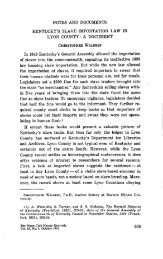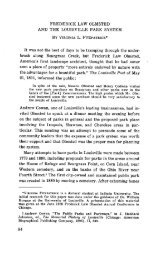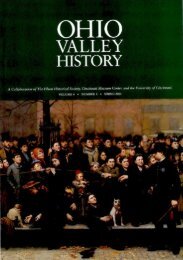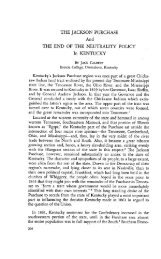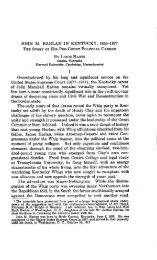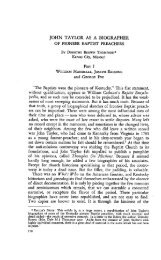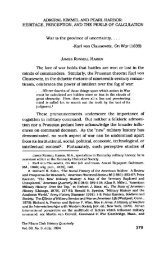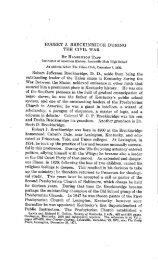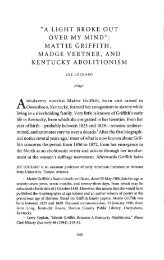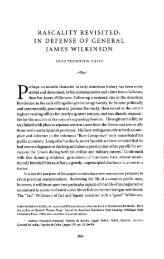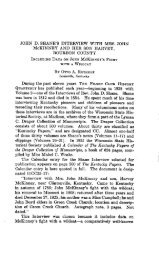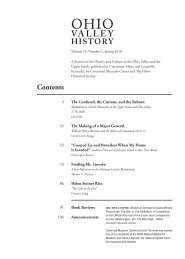Eskippakithiki, The Last Indian Town in Kentucky - The Filson ...
Eskippakithiki, The Last Indian Town in Kentucky - The Filson ...
Eskippakithiki, The Last Indian Town in Kentucky - The Filson ...
You also want an ePaper? Increase the reach of your titles
YUMPU automatically turns print PDFs into web optimized ePapers that Google loves.
Voh 6] <strong>The</strong> <strong>Filson</strong> Club History Quarterly 377<br />
<strong>in</strong> the Year 1770 I Incamped on Red River with five other men<br />
and we had for our amusement the History of Samuel Gulivers<br />
Travels where<strong>in</strong> he gives an account of his young Mistress Glumdeclik<br />
earri<strong>in</strong>g him on a Market Day for a show to a town called<br />
Lulbergrud a young man of our Company Called Alexander Neely<br />
came to Camp one Night and told us he had been that Day to<br />
Lulbergrud and had killed two Brobdernags <strong>in</strong> their Capital.<br />
there was no place <strong>in</strong> this County went by that name of the log<br />
Lick until the year 1795 when William and Major Beezley Cut a<br />
number of Trees Down <strong>in</strong> and about this Lick we are now at <strong>in</strong><br />
order to ketch Buffalows and from that time some people called<br />
this the Log Lick," etc.<br />
From this it is seen that Lulbegrud is a corruption of Lorbrulgrud,<br />
the capital of Brobd<strong>in</strong>ag, the land of giants, which, accord<strong>in</strong>g<br />
to Dean Swift, Gulliver discovered on the northwest coast of<br />
America. <strong>The</strong> present Oil Spr<strong>in</strong>gs was the "capital" and the<br />
buffalos l<strong>in</strong>ger<strong>in</strong>g around them, the "Brobdernags."l,<br />
WHAT THE SETTLERS FOUND AT INDIAN OLD FIELDS: A large<br />
part of the <strong>Indian</strong> Old Fields was patented by a company from<br />
Berkeley County, Virg<strong>in</strong>ia, composed of General Marquis Calmes,<br />
and son, Marquis, Jr., Edward Berry, and Ben and Cuthbert<br />
Combs. <strong>The</strong> two Combs were brothers, and their mother was a<br />
sister of Colonel Thomas Bullitt, the pioneer of Louisville. William<br />
Risk, an <strong>in</strong>telligent settler, some sixty years later, gave Rev.<br />
John D. Shane the follow<strong>in</strong>g description:<br />
"I heard one of the partners, Gen. Calmes, say the Old Fields<br />
were all covered with bluegrass when he first saw it [<strong>in</strong> 1775]. And<br />
when I first saw it, it was very high with grass, as high, some, as a<br />
horse's back, and with a head to it.... <strong>The</strong>re were sprouts of<br />
white hiccory, and cherry tree, and black locust, and black walnut,<br />
all through the Old Field . . . <strong>The</strong>re were stumps, some off<br />
as high as a chair back, and around these stumps were trees, some<br />
of them would make five rail cuts.... Suppose some of the<br />
trees had been cut down to put up a white oak pole cab<strong>in</strong> that<br />
was . . . there and looked old when the partners were tak<strong>in</strong>g up<br />
the land.... It was known as the cab<strong>in</strong> on the white oak po<strong>in</strong>t.<br />
It is now on Leonard Beall's land, jo<strong>in</strong><strong>in</strong>g to Mrs. Goff's down on<br />
Howard's creek. <strong>The</strong> cab<strong>in</strong> was hardly one-half mile from the<br />
gate posts.... Ben Combs said he did not know who made it.<br />
• . . <strong>The</strong> posts were two, of black walnut, about as far apart as a



